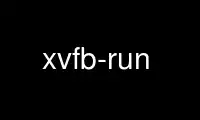
This is the command xvfb-run that can be run in the OnWorks free hosting provider using one of our multiple free online workstations such as Ubuntu Online, Fedora Online, Windows online emulator or MAC OS online emulator
PROGRAM:
NAME
xvfb-run - run specified X client or command in a virtual X server environment
SYNOPSIS
xvfb-run [ options ] command
DESCRIPTION
xvfb-run is a wrapper for the Xvfb(1x) command which simplifies the task of running
commands (typically an X client, or a script containing a list of clients to be run)
within a virtual X server environment.
xvfb-run sets up an X authority file (or uses an existing user-specified one), writes a
cookie to it (see xauth(1x)) and then starts the Xvfb X server as a background process.
The process ID of Xvfb is stored for later use. The specified command is then run using
the X display corresponding to the Xvfb server just started and the X authority file
created earlier.
When the command exits, its status is saved, the Xvfb server is killed (using the process
ID stored earlier), the X authority cookie removed, and the authority file deleted (if the
user did not specify one to use). xvfb-run then exits with the exit status of command,
except in error conditions (see EXIT STATUS below).
xvfb-run requires the xauth command to function.
OPTIONS
-a, --auto-servernum
Try to get a free server number, starting at 99, or the argument to --server-num.
-e file, --error-file=file
Store output from xauth and Xvfb in file. The default is /dev/null.
-f file, --auth-file=file
Store X authentication data in file. By default, a temporary directory called
xvfb-run.PID (where PID is the process ID of xvfb-run itself) is created in the
directory specified by the environment variable TMPDIR (or /tmp if that variable is
null or unset), and the tempfile(1) command is used to create a file in that
temporary directory called Xauthority.
-h, --help
Display a usage message and exit.
-n servernumber, --server-num=servernumber
Use servernumber as the server number (but see the -a, --auto-servernum option
above). The default is 99.
-l, --listen-tcp
Enable TCP port listening in the X server. For security reasons (to avoid
denial-of-service attacks or exploits), TCP port listening is disabled by default.
-p protocolname, --xauth-protocol=protocolname
Use protocolname as the X authority protocol to use. The default is ‘.’, which
xauth interprets as its own default protocol, which is MIT-MAGIC-COOKIE-1.
-s arguments, --server-args=arguments
Pass arguments to the Xvfb server. Be careful to quote any whitespace characters
that may occur within arguments to prevent them from regarded as separators for
xvfb-run's own arguments. Also, note that specification of ‘-nolisten tcp’ in
arguments may override the function of xvfb-run's own -l, --listen-tcp option, and
that specification of the server number (e.g., ‘:1’) may be ignored because of the
way the X server parses its argument list. Use the xvfb-run option
-n servernumber, --server-num=servernumber to achieve the latter function. The
default is ‘-screen 0 640x480x8’.
-w delay, --wait=delay
Ignored for compatibility with earlier versions.
ENVIRONMENT
COLUMNS
indicates the width of the terminal device in character cells. This value is used
for formatting diagnostic messages. If not set, the terminal is queried using
stty(1) to determine its width. If that fails, a value of ‘80’ is assumed.
TMPDIR specifies the directory in which to place xvfb-run's temporary directory for
storage of the X authority file; only used if the -f or --auth-file options are not
specified.
OUTPUT FILES
Unless the -f or --auth-file options are specified, a temporary directory and file within
it are created (and deleted) to store the X authority cookies used by the Xvfb server and
client(s) run under it. See tempfile(1). If -f or --auth-file are used, then the
specified X authority file is only written to, not created or deleted (though xauth
creates an authority file itself if told to use use that does not already exist).
An error file with a user-specified name is also created if the -e or --error-file options
are specifed; see above.
EXIT STATUS
xvfb-run uses its exit status as well as output to standard error to communicate
diagnostics.
0 xvfb-run only uses this exit status if the -h, --help option is given. In all
other situations, this may be interpreted as success of the specified command.
1 Xvfb did not start correctly.
2 No command to run was specified.
3 The xauth command is not available.
4 The temporary directory that was going to be used already exists; since xvfb-run
produces a uniquely named directory, this may indicate an attempt by another
process on the system to exploit a temporary file race condition.
5 A problem was encountered while cleaning up the temporary directory.
6 A problem was encountered while using getopt(1) to parse the command-line
arguments.
EXAMPLES
xvfb-run --auto-servernum --server-num=1 xlogo
runs the xlogo(1x) demonstration client inside the Xvfb X server on the first
available server number greater than or equal to 1.
xvfb-run --server-args="-screen 0 1024x768x24" ico -faces
runs the ico(1x) demonstration client (and passes it the -faces argument) inside
the Xvfb X server, configured with a root window of 1024 by 768 pixels and a color
depth of 24 bits.
Note that the demo X clients used in the above examples will not exit on their own, so
they will have to be killed before xvfb-run will exit.
Use xvfb-run online using onworks.net services
